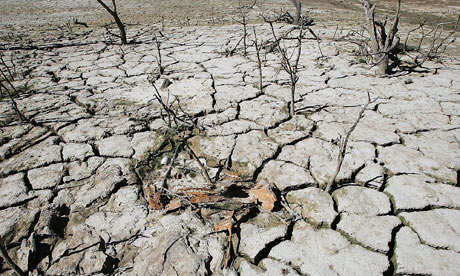Rainwater harvesting: dismissed by Texas voters but embraced by business

Lake Eucumbene in Old
Adaminaby, Australia. Rainwater collection played a key role in getting
several Australian cities through their recent 'millenium drought'.
Photo: Mark Nolan/Getty Images
The project list is heavy on big new pipelines and reservoirs (including a controversial $3.3bn reservoir in East Texas to service the Dallas-Fort Worth metroplex 170 miles away), and also features agricultural conservation and municipal water reuse projects.
But advocates of rainwater collection say a key tool for water security is missing from the plan. "Rainwater harvesting was not recommended as a water management strategy to meet needs since the volume of water may not be available during drought conditions," the plan states.
Rainwater harvesting – one of the most efficient ways of reducing water demand and related infrastructure costs, according to Tamim Younos, president of Virginia's Cabell Brand Center – has gained popularity in recent years. To protect themselves from water shortage or price increases, some of the world's largest companies – such as Walmart, Home Depot, and TD Ameritrade – have been installing their own projects.
While Texas offers a number of incentives for rainwater harvesting, including allowing governmental districts to exempt such systems from property taxes, inclusion of the practice in the State Water Plan would have certainly accelerated the trend.
Rainwater collection played a key role in getting several Australian cities through their recent "millennium drought". But the practice routinely gets overlooked in the United States, as underlined by the Texas plan.
David Crawford, founder of Virginia-based Rainwater Management Solutions, attributes the limited US rollout to resistant utilities, relatively low water costs, a confusing melange of local codes and ignorance about the practice.
"There's these municipalities that say, 'Oh, no, we don't want you to flush our toilets with rainwater because we'll lose budget money on it,'" Crawford said. "The reality of it is they don't have the water to sell in many cases."
Corporate rainwater collection rises
In May, online brokerage TD Ameritrade Holding Corporation consolidated five offices in Omaha, Nebraska, into a single $250m, 12-story tower expected to receive the LEED Platinum certification.Along with an abundance of natural lighting, solar-heated hot water, and wind-powered parking lot lights, the building boasts a rainwater harvesting system that waters the landscaping and flushes the toilets. All together, the green measures cut building maintenance costs in half, claims spokesperson Kim Hillyer.
"Anytime you move 2,000 people into one location you worry about how many natural resources you're going to drain, and if we can limit that then we've done our job in being a good community partner," Hillyer said.
Box stores with large roofs and significant landscaping also appear to be a natural fit for rainwater harvesting, which typically involves collecting rainwater from rooftops, storage in large tanks, and filtration and pumping for non-potable needs. The American Water Works Association estimates that 80% of the typical commercial building's water use goes to non-potable uses, such as flushing toilets, watering landscaping, and for cooling and processing water.
Read More Here












No comments:
Post a Comment
Hello and thank you for visiting my blog. Please share your thoughts and leave a comment :)